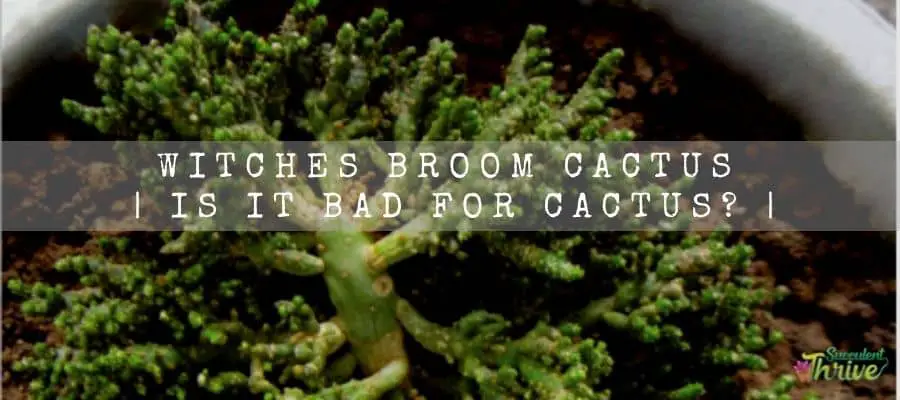Witches broom cactus or witches broom disease is a common disease among cactus. Would you like to know more about this disease and how to cure it? If so, this article is for you. Let’s dig in.

What is witches broom cactus disease?
Witches broom disease is a sign of stress that you could spot among the woody plants and shrubs (not only cactus).
Once they go through this condition, it would lead to a deformed mass of twigs and branches as well. Those deformations would tend to look like brooms.
In fact, they tend to look unusual in tehri looks and that characteristic makes them called witches’ brooms.
There are a number of factors which contribute to this condition. In fact, those reasons could factor in the proliferation of shoots which would arise with short internodes.
One might think that they look like a bundle of twigs or witches’ brooms. Further chances are that they may also appear as ball shaped dwarf plants too.
So, if you are curious to discover more on this subject, it would be worth reading this article. Let us begin to discover these mysterious things!
Witches broom disease caused by
Witch broom disease is a result of stress which could mainly take place due to pests and to diseases.
Mites, aphids, nematodes to fungi, viruses and some other bacterial organisms such as phytoplasmas could contribute to this condition.
Not only that but also,parasitic plants like mistletoe may also factor in this condition.
In addition to that there could be some environmental factors which could also lead to this condition. Furthermore, genetic mutations may also contribute to this condition.
We could elaborate further on this considering the pine brooms as they are commonly caused by rust fungus. As aforesaid fungal infections may also contribute to this condition.
If we consider on peach trees and black locust, they will mainly go through the Witches broom disease Due to viral infections.
On the other hand, trees like Hackberry trees experience this condition both fungal infections and by mite attacks. Mites is a commonly spotted root cause which could result in this condition.
On the other hand, aphids would be mainly responsible for creating the Witches broom disease in honeysuckle shrubs.
To further elaborate on this, phytoplasmas is a commonly spotted parasitical bacteria which would commonly attack the phloem.
Further they may also attack the structures which are accountable for the food transportation in the network of the trees.
The transmission of these bacteria would occur due to insects. Phytoplasmas could be so annoying as they could invade numerous plants be it wine grapes to coconut palms.
Ultimately, they would obstruct the food circulation and the energy circulation of the host plants.
In addition to that insects’ types such as aphids, mites may carry a pathogen which would result in the Witches broom disease.
These insects can pass the pathogen to the plants they feast on. To further elaborate on this, a viral infection which occurs by mites causes the Witches broom disease.
Further it would result in rose rosette disease after that. At the end you would see the rosebuds and stems become stunt.
They would produce small leaves along with excessive thorns. Further you could spot them in red. In addition to that it is very unlikely that those rosebuds would blossom into flowers too.
Dwarf mistletoe is yet another parasite which would mainly infect the pine species and some other conifers.
Dwarf mistletoe are small leafless plants which would usually on trees, and they obtain all of their water and nutrients from the host plants.
These parasitic plants would attack the tissues of the host tree and lead to the Witches broom disease. Once the host trees suffer from this condition, it would be very difficult to revive them.
Powdery mildew is a commonly spotted fungus in nature. They would mainly tend to attack the oak trees and they would also result in the Witches broom disease.
If you expose your plants for rainy conditions along with warm weather, it will attract the powdery mildew.
So, trees react in forming the Witches broom disease as a way of responding to the powdery mildew.
Once they experience this condition, they would interrupt the photosynthesis process.
Which hormone is responsible for a disease called witches broom?
It is cytokinin hormone which would lead to the Witches broom disease.
It is what would ruin the entire structure of the cell organization of the plants. They would usually arise in the root apical meristems.
The apical meristems are the tips of the roots which you could spot at the opposite end of the plant from auxin. They would move up in the plants whilst circulating up the stem.
cytokinin hormone and the auxin function closely. So, if there are equal components of both cytokinin hormone and auxin, they would result in the normal cell division.
If auxin components increase, you could see how they produce shoots.
On the other hand, if cytokinin concentration increases than the auxin, they would still develop the shoots which would ultimately call the Witches broom disease.
To briefly explain what Auxin is, it is a plant hormone which is mainly responsible for cell growth and for cell expansion also.
This hormone will circulate from top to the bottom of the plants. Usually, the Auxin component is high towards the top part of the plants whereas it would be somewhat low towards the bottom part of the plants.
Auxin mainly ensures that the plant’s shape is in place. Literally it would avoid the lateral buds and branches growing on the trunks.
In simple words, auxin is responsible for the apical dominance in the plants.
So once, any organism attacks the trees, it would interrupt the auxin circulation in the plants.
It would imbalance the control between the cytokinin and auxin and ultimately it would make them produce shoots uncontrollably in a messy way.
Witches broom disease symptoms
At first you could spot the densely grown clusters of branches or twigs.
They would usually arise from a central source. Once they grow these in all directions it would give them the look of a broom.
You could identify this significantly specially on the deciduous trees. If we consider needle plants like pines, you could see how they produce denser needles.
Chances are that there could be just one broom seen or many. Further those brooms may appear in various sizes as well.
Once a plant is infected with this, you could see an enhancement of the thickness of the plants. The infected branches would tend to take a swollen look.
Literally a large number of tiny branches would form on the infected branches. The infected branches would consist of densely grown foliage and the non-infected branches would form around the infected branches.
Dwarf mistletoe shoots would form the enlarged infected branches and you could easily identify them as well.
On the other hand, if the infections take place on small trees, it will cause rapid mortality.
Moreover, the large trees would slow their growth rate once the witch broom infection takes place.
In addition to that you could see how the upper part of the foliage becomes short and sparse. Further they would tend to take a yellowish color as well.
The upper crown of the plants would tend to die back. Once they deteriorate their growth pattern, it would ultimately result in the death of the plants.
Witches’ broom disease treatment
Unfortunately, there is no treatment to treat the Witches broom disease.
However, what you could do to overcome them is to prune the infected section of the plants. You need to ideally prune several inches below their formation in the plants.
How do you control a witch’s broom?
You need to prune out the infected branches first. Further you may also cut back the shoots where the larger branches connect to the trunks.
This is more like an organic approach. If you think, the witch broom formation makes your plants look aesthetically look ugly, pruning them would be the best option to do. That will allow you to remove the affected branches, twigs and the buds as well.
Once you make the cuttings, you need to discard them properly too. Do not dispose of them improperly as then it would make them decay and lead to other fungal infections, insect attacks.
You need to clean your tools properly once you cut the witch’s broom. Further, I recommend disinfecting the tools also so that it would minimize a further potential of transferring these to unaffected branches.
If you are a fresher in gardening, there are professionals who can assist you with the pruning of the plants.
The professionals should be able to further assist you with treating the root causes of the witch’s broom disease. In fact, if your precious plants are in stress, it could lead to witch’s broom disease.
So, once you treat the root causes of the witch’s broom, it is very unlikely that you will have to deal with this menace.
Read Next : 06 Major Fairy Castle Cactus Problems


